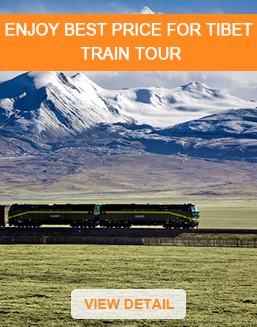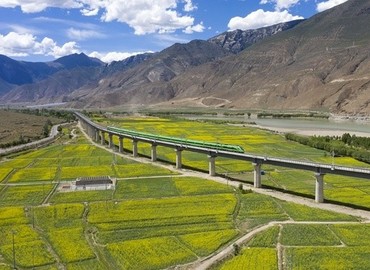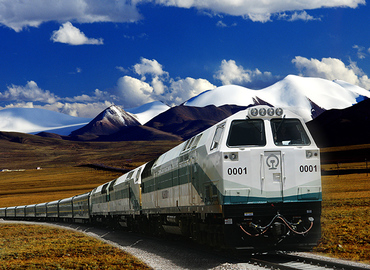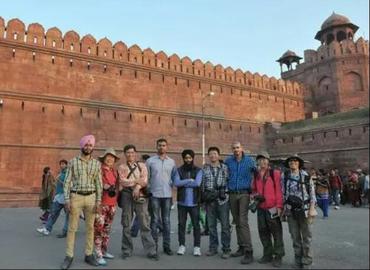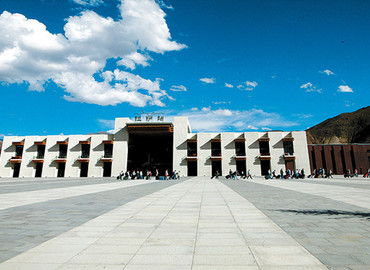Qinghai Tibet Railway
- Beatrice
- Last Updated : 06/11/2024
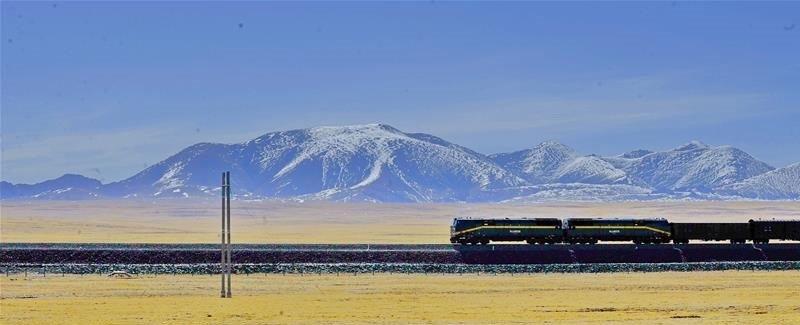
Train to Tibet is listed as one of the "World's top 25 iconic rail adventures". Riding a train to Lhasa has become a rather good choice for traveling to Tibet with the completion of the world's highest railway - the Qinghai-Tibet Railway, which is also the only railway to Lhasa from mainland China at present. Along the way, you will see unique plateau landscapes, such as the blue sky, white clouds, desert landscape, snow-capped mountains, green pasture, sheep and yaks grazing the grassland, sapphire lakes, the source of Yangtze River, Hohxil Natural Reserve, etc. Taking a train to Tibet, you will not only enjoy the gorgeous natural scenery of the Qinghai-Tibet Plateau but also witness the Tibetan cultural landscape. And, of course, enjoying the high-quality services on Qinghai-Tibet Railway is also a wonderful experience.
The Qinghai-Tibet Railway, the only railway that links the Lhasa railway station to the existing rail network of mainland China, is always busy throughout the year. Because Tibet is called the roof of the world, the Qinghai- Tibet railway system is called the sky road itself. Starting from Xining City, Qinghai Province, this railway passes through Golmud City, Kunlun Mountain Pass, and Yanhe Riverside then crosses Tanggula Pass and enters the Tibet Autonomous Region of Amdo, Nagqu, Dangxiong, Yangbajing, and Lhasa. The total length of the Qinghai-Tibet Railway is 1,956 kilometers(1,215 miles) and it's an important entryway into Tibet.
The Qinghai-Tibet Railway itself is also a man-made world wonder. The Tibet Railway creates many of the world’s firsts: the world’s highest railway, the world's highest railway station, the world’s longest track on frozen earth, etc.
An Engineering Marvel
The odds and difficulties in building the Qinghai-Tibet Railway were great and building this railway network necessitated state-of-the-art engineering. Some experts had previously said that building such a railway across the Kunlun Mountains would be “next to impossible.” Why? — because this railway traverses a region known for earthquakes, low temperatures below zero degrees, a high altitude of 5,000m, and low atmospheric pressure. Yet, this apparent impossibility of building the Qinghai-Tibet Railway did not deter its builders from actualizing this seemingly impossible feat. And eventually, the Qinghai-Tibet Railway was built and inaugurated on July 1, 2006.
Rail Lines Connect Tibet and Mainland China
In the beginning, only three trains ran: Beijing–Lhasa (every day), Chengdu/Chongqing–Lhasa (every other day), then Lanzhou/Xining–Lhasa and Shanghai/Guangzhou–Lhasa services were added in October 2006. From July 2010 the Shanghai–Lhasa service became daily, and a daily service between Xining and Lhasa was added.
It is relatively cheap and convenient to have a train trip to Lhasa from other inland cities in China. At present, there are direct trains to Tibet from Xining, Beijing, Shanghai, Guangzhou, Chengdu, Chongqing, Xi’an, and Lanzhou. Many trains to Tibet beginning from other cities will pass by Xining, Xian, Lanzhou or Golmud. Therefore, not surprisingly, Qinghai-Tibet Railway is so attractive to both domestic and foreign tourists. The popularity of the Tibet train tours results in huge demand for train tickets among tourists. It is very hard for individual travelers to obtain a Tibet train ticket during the peak tourism season. Great Tibet Tour can help you book Tibet train tickets easier. Still, it is quite difficult to guarantee a first-class soft sleeper berth ticket from Beijing, Shanghai, and Chengdu, as the three places are popular gateway cities for many foreigners to China.
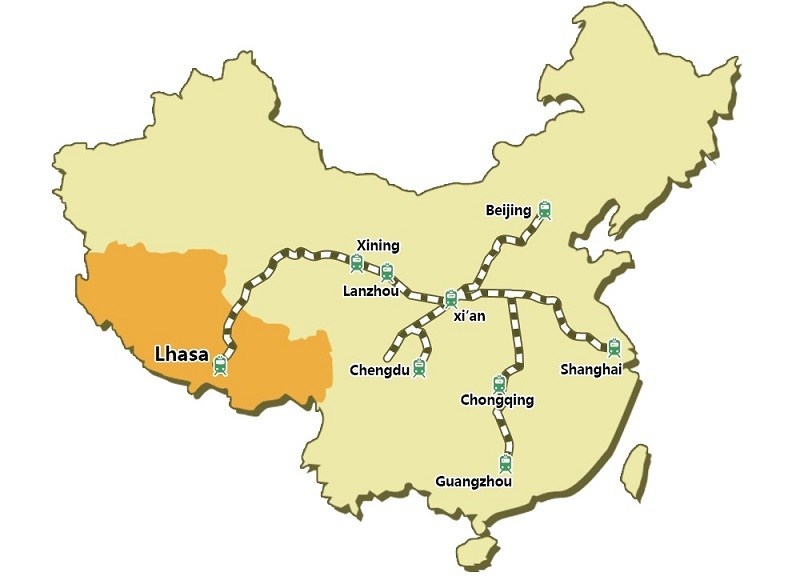
Scenes Along the Tibet Railway
This is a tourist line as most passengers on the train can witness the scenery of the Qinghai-Tibet Plateau such as lakes, rape flowers, green grass, snowy mountains, creeks, etc. Every a while, the broadcast on the train will introduce the following scenic spots in detail. It makes you feel like there's a tour guide around you.
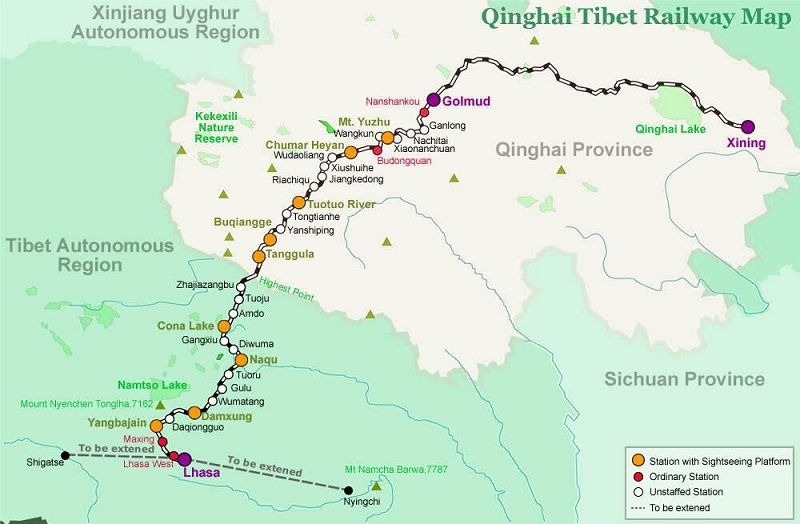
The beauty of nature alongside the rail track is heavenly and breathtaking. Almost all trains start crossing the Qinghai-Tibet Plateau during daylight, guaranteeing you great views. After the train departs from Xining, you will see Qinghai Lake soon, which is China's largest saltwater lake, and the Tibetan and Mongolian nomads live around the lake. Then you will pass Guanjiaoshan Tunnel, the highest tunnel on the Qinghai-Tibet Railway from Xining to Golmud, at an altitude of 3,690 meters. After this tunnel, you will see less and less vegetation until the next stop, Delingha. Delingha is 530 kilometers(329 miles) away from Xining, 387 kilometers(240 miles) west of Golmud, and 2,982 meters above sea level. Delingha is Mongolian, which means that when the golden field is approaching Delingha, you can see some scattered Little Salt Lakes. After the railway sets out of Delingha, the road is completely a scene of the Gobi Desert. After 2hrs 30mins, you will see another important city - Golmud along the Qinghai-Tibet Railway besides Xining. Golmud is Mongolian, which means that there are many rivers. It is 845 kilometers(525 miles) away from Xining, more than 1,200 kilometers(746 miles) from Lhasa, and more than 2,800 meters above sea level. It's known as the pearl of the Qaidam Basin.
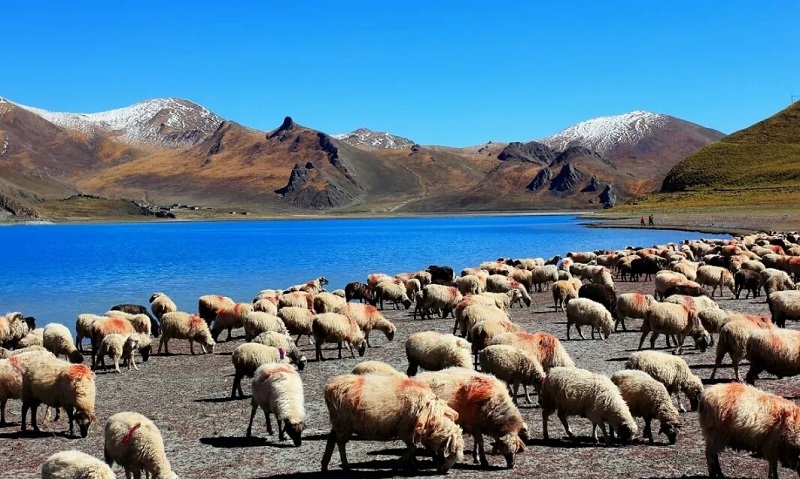
From Golmud, the train climbs through the desert into the jagged caramel-colored mountains of Nanshankou(Southern Pass), before crossing the Tanggula Pass, the railway has been running to the Kunlun Mountains in parallel with National Highway 109. The surrounding is no longer the rolling hills you saw before, but lofty and majestic mountains. You will see Yuzhu Feng(Jade Pearl Peak, 6,178m) soon, which belongs to Coco Saigemon Mountain Range. Coco Saigemon is Mongolian, which means a beautiful and dangerous girl. It stands about 170 kilometers(106 miles) southwest of Golmud. There are 15 snow-capped mountains above 5,000 meters above sea level and lined from east to west. The glaciers and snow on the top of the mountains also created a wonderful beauty.
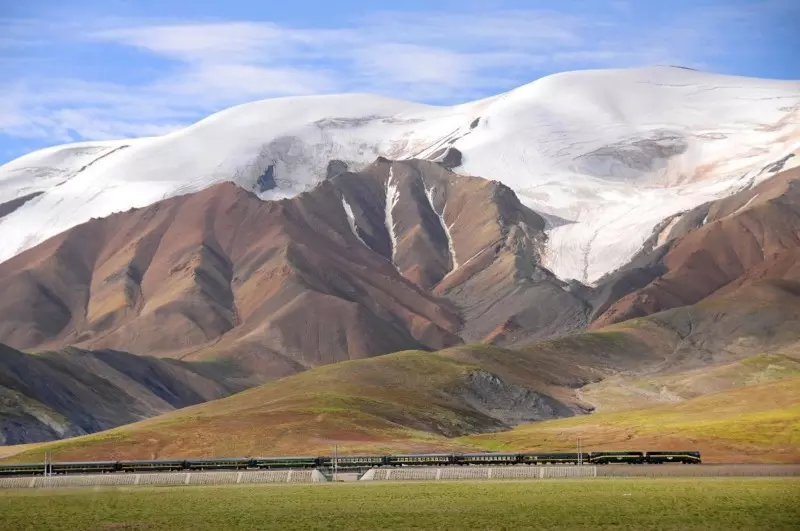
Continuing your trip to the south, you will observe the beauty of the slow-flowing, 800km broad- Tongtian River, then experience the beauty of the underlying chain of the Tanggula Mountains. Running deeper into the Tanggula Mountains, the train stops at Tanggula station at 5,068m, the world's highest train stop. Tanggula Mountain is divided into eastern and western parts; the western part allows you to experience a cold and desert vista, and the eastern part has a beautiful view of shrubs and grassland.
Departing from the Tangula mountain stop, the train begins to enter Tibet Autonomous Region. When passing by the 4,776m Kunlun Pass, where you can see the prayer flags, and Cona Lake, 9.5hrs from Golmud near Amdo, claimed to be the highest freshwater lake in the world at 4,608m. The train crosses into Tibet over the 5,072m Tangula Pass, the line’s high point. After this point, the line enters the Tibet section. Keep your eyes peeled throughout the journey for Tibetan antelope, fox, and wild asses, plus the occasional nomad. You will experience the beauty of the Nagqu district of the northern part of Tibet, and then you move to Northern Grassland. You can’t stop yourself to experience the natural scenery here which has a painting of blue sky, white clouds, a colorful rainbow, and cattle like cows, sheep, and green grass.
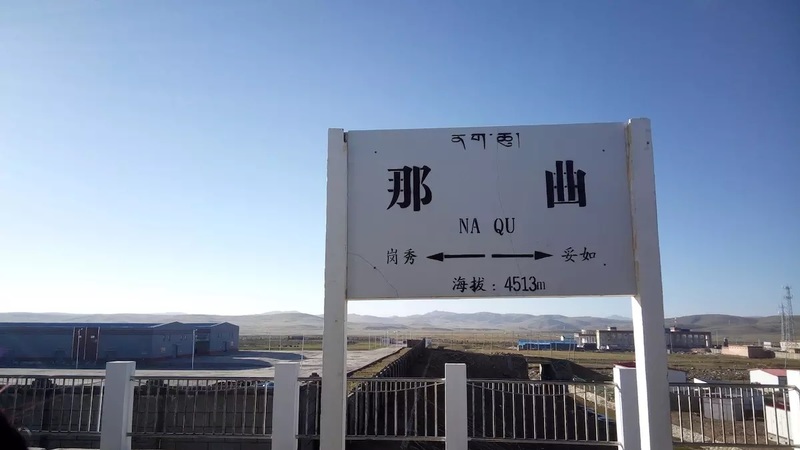
After Nagqu, the train heads toward another moorland marsh. You will experience the beautiful scattered herdsmen huts, surrounded by greenery and grazing cattle. From here, you enter Damxiong, a town in the east of Namtso Lake. It gives you a feel of the lush place, the same as Lhasa.
Your train journey will reach the last mountain chain, Nyainqentanglha Mountains, running along the railway. In the west direction, you will experience the charm of 7,000 meters high, four peaks on the Dumxiong grasslands. Then you reach YangpachenTown, where you can see beautiful gorges, and then you approach Duilongdeqing County. You will see trees, and most of them are Tibet Willow.
After enjoying all the beautiful scenery, you will see the beauty of the Lhasa Rivers, and finally, you reach your destination - Lhasa.
>> See more about the scenery along with Qinghai Tibet Railway
Here's a video about the Qinghai-Tibet railway for watching the details.
What About Oxygen and Health?
The trains on the Qinghai- Tibet railway are built to have an oxygen supply for all the passengers. Each train contains two oxygen provision systems. The first system ensures oxygen provision in the entire train through temperature and air pressure control. The other system helps people individually by providing them with oxygen through individual ports. Moreover, there are oxygen masks in each cabin in case of an emergency. Adding to this, to ensure the passengers’ safety, each train has a doctor on board along with necessary medical equipment and medicines. These arrangements are necessary because of the high-altitude region with a lack of oxygen.
At the time of ticket purchasing, one must acquire a passenger health registration card which includes notices about the high-altitude region, and the dangers related to oxygen. Each individual must sign an agreement to acquire this health registration card.
Is It Safe for Foreigners in Tibet Train?
It is quite safe for foreigners on the train to Tibet, and most foreign travelers choose the soft sleeper coaches with doors. At night, the doors can be closed and locked. Every night before the lights out, the train attendants will check your train tickets. Those without corresponding tickets will be asked to leave and return to their original seats before closing the soft sleeper coach. Hard-Sleeper Berth Compartments have no doors of their own. No matter which kind of train tickets you choose, please be careful with your valuables.
FAQs about Tibet Train
All the frequently asked questions about the Tibet train.
-
Q: Is Tibet Train Punctual?
- A: The departure of the Tibet train is usually very punctual. The arrival of the Tibet train is not as punctual. Give it 100mins or so of delay.
-
Q: Do Train Attendants on Tibet Train Speak English?
- A: No attendant on Tibet train speaks fluent English, though some of them speak some simple English. If you encounter some trouble in communication, please seek the help of other passengers. Young people in China more or less speak a little English. Or call your travel consultant of Great Tibet Tour, who would be happy to help you at all times.
-
Q: Is There a Private Bathroom On Tibet Train?
- A: There is no private bathroom available on Tibet Train, but public bathrooms with a sink area on one side of the carriage. You will be sharing the bathroom with the rest passengers in the carriage. Also, train attendants will constantly clean it. Note that there's no toilet paper available in the bathroom.
-
Q: Can I Take a Shower on Tibet Train?
- A: There is no shower available on the Tibet train.
-
Q: Is There Internet Access on Tibet Train?
- A: There is no internet access on Tibet Train.
-
Q: Is Mobile Phone Accessible on Tibet Train?
- A: There's a weak signal for mobile phones most of the time.
-
Q: Are There Electric Outlets on Tibet Train?
- A: In the soft-sleeper compartment, there's an electric outlet in the private cabin, and three in the corridor. In the hard-sleeper compartment, only three electric outlets in the corridor.
- Q: Is There Any Entertainment Facilities on Tibet Train?
- A: Almost no other entertainment except Railway TV in soft sleeper berth cars. Views along the way are your main entertainment.
- Q: Is There Hot Water Supply on Tibet Train?
- A: Each car of the Tibet train is equipped with a 24-hour hot water supply, from which you can get boiled hot water. You can get the hot water in the sink area.
Email response within 0.5~24 hours.


